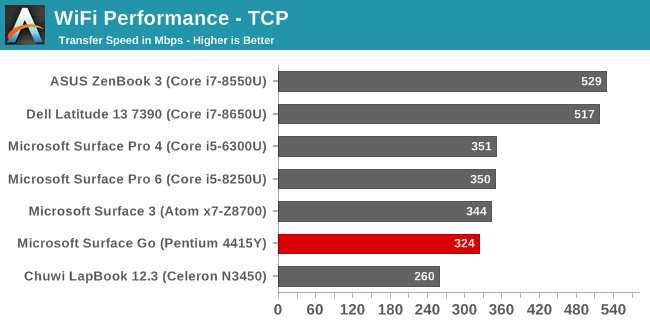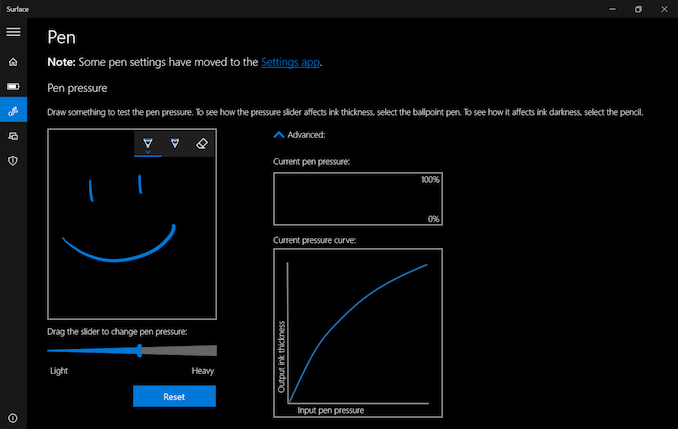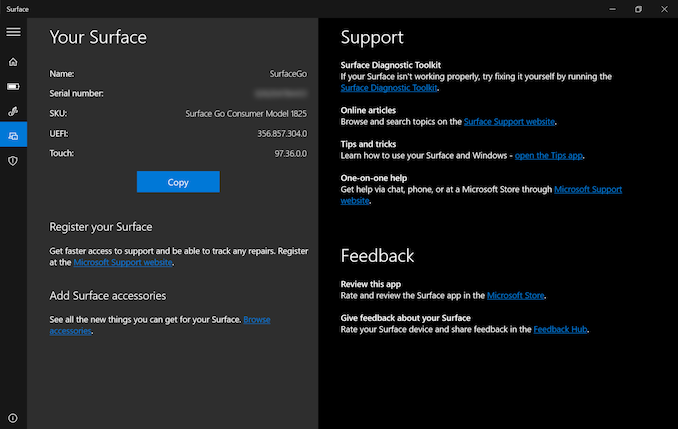The Microsoft Surface Go LTE Review: Unmatched Mobility
by Brett Howse on January 17, 2019 8:00 AM ESTWireless
Microsoft has relied on the Marvell AVASTAR wireless card for pretty much the entirety of their Surface lineup, so it was a bit surprising to see the Surface Go LTE come with a Qualcomm wireless solution in the QCA6174A product. This is a 2x2:2 MU-MIMO 802.11ac chip, with integrated Bluetooth 4.2. Likely the Qualcomm Wi-Fi is being used because Microsoft has also incorporated the Qualcomm Snapdragon X16 LTE modem in this product.

If the Surface lineup had a particular fault, it would be on the wireless performance, and despite the Surface Go offering a different Wi-Fi solution than the typical Marvell we see in Surface devices, the Surface Go still has the same mediocre wireless performance as the rest of the lineup. It is really something the company needs to address.
As far as the cellular, we won’t do bandwidth testing on this for the same reason we don’t do it on phones. The disparity in cellular connection speeds and supported standards is just too varied to provide an accurate result.
The addition to cellular in this device is pretty interesting though, and really opens it up to a much wider audience. Microsoft is clearly targeting business with the Surface Go LTE, although there’s definitely going to be consumer interest as well in having a device that is always connected. Not only will remote workers have a more reliable connection to the corporate network, but it will make it easier for IT to manage as well. It’s nice to see Microsoft pushing the Always Connected PC with their own products. For those that need more performance, the Surface Pro can be had with LTE, but for those that need mobility, Microsoft now offers a product in that category as well, since it’s been a few years since the Surface 3 LTE was made available.
Audio
The Surface Go continues with the design tricks of the Pro by hiding the speaker grilles in the black part of the display bezel. This makes them almost hidden, but provides the benefit of firing the drivers forwards, and providing good stereo separation.
The speakers in the Surface Go sound like a typical small PC though, with not much low end, but these ones are even quieter than most devices, averaging around 71 dB(A) measured an inch over the trackpad.
Thermals
If only all other devices were able to run as cool and quiet as a Surface Go, but alas, they are after performance. With just a 6-Watt TDP, and a 4.8-Watt SDP, the Intel Pentium Gold 4415Y can be easily cooled in a fanless design, so despite trying to see if the meager 1.6 GHz frequency would droop over time, it does not, and the Surface Go never gets very warm. This is the dream. We just need to tie some performance to it.
Software
The Surface Go comes with Windows 10 Home in S Mode, although businesses can also purchase it with Pro if they don’t have an Enterprise agreement. The S Mode is something Microsoft has been hoping would take off for some time, but if you do need to install apps that are not in the store, you can turn it off, although it must be noted that is a one-way switch. To go back to S Mode you would have to recover the device.
As with all Surface models, there’s a clean image to work with. The only real addition is a couple of apps, such as the Surface App where you can configure the pen, check the battery life of Microsoft accessories, or go for support. Most Surface devices tend to ship with a few other additions like Sketchable for use with the pen, and a couple of others, but nothing that can’t be removed with a couple of clicks.
Overall, it’s a clean image, and it needs to be since the base model ships with just 64 GB of storage.













79 Comments
View All Comments
Ashinjuka - Saturday, January 19, 2019 - link
Cats and dogs lying down together.TheinsanegamerN - Saturday, January 19, 2019 - link
Mass hysteriaDeath666Angel - Thursday, January 17, 2019 - link
"while being decent in legacy code" I'm not holding my breath.But I am serious surprised that this thing is worse than Atom based Celeron and Pentium CPUs. I guess not having any turbo really hurts it.
tipoo - Thursday, January 17, 2019 - link
The Snapdragon 845 Windows laptops showed about a 50% loss in running x86 code fwiwTheinsanegamerN - Saturday, January 19, 2019 - link
*on average.50% on average is horrible, because remember, "on average" means half are worse then that. You could have two apps, one 25% slower and one 75% slower, and hit that 50% mark. Users of the second app, however, would not be happy.
Anything with FPU intensive code or spaghetti code dogs down to near unusability on ARM. Most of the well running apps on windows ARM are basic apps that dont need intensive processor resources, apps simple enough to port to ARM natively.
deathBOB - Thursday, January 17, 2019 - link
Ooof what a dog.Too bad, it’s a cool design.
PeachNCream - Thursday, January 17, 2019 - link
The word "flagship" is necessary for something to be cool these days. Anandtech only grants the flagship moniker to thousands of truly impressive mid-range products.cknobman - Thursday, January 17, 2019 - link
Close but no cigar.Microsoft charging $100 for the stupid type cover is downright robbery.
Maybe if it was just that in isolation I could give in but there are just too many other comprimises.
The 64GB hdd in the base model is too small and would barely even support updating Windows 10 properly in the future.
Intel with their price raping strategy refuses to make offer a processor with enough performance at a decent price. If this same chip just had a turbo boost capability it would be fine.
The battery is too small. Again this in isolation would not be a big deal but combined with the other compromises it just too much.
So by the time you add a keyboard and enough storage you are spending WAY TO MUCH $$$ to still have crippled performance and battery life.
tipoo - Thursday, January 17, 2019 - link
Also that the 64GB base model is horribly slow eMMC.Prestissimo - Saturday, January 19, 2019 - link
$800 USD to be exact, excluding shipping and taxes. For a 10" Windows tablet PC with PENTIUM and 3 HOURS of actual battery life that is NOT REPAIRABLE.This is as hilarious a fiasco as that Google's Chromebook thing they've been making for some time.